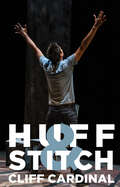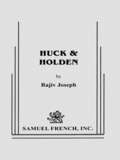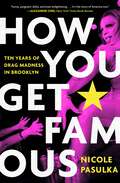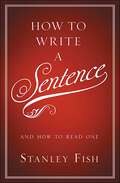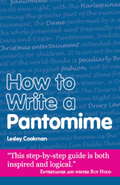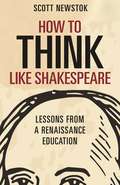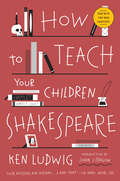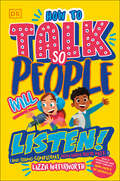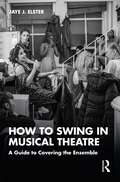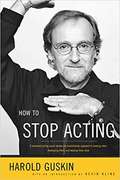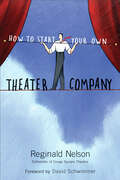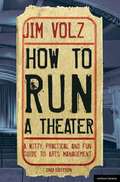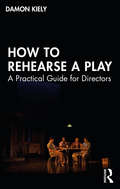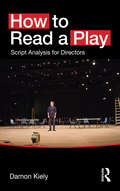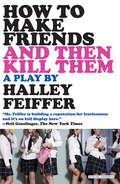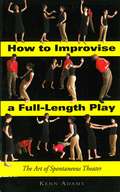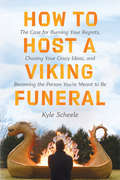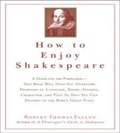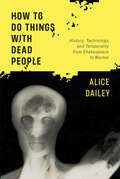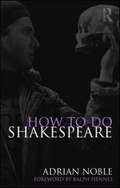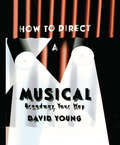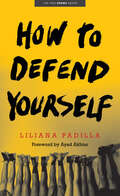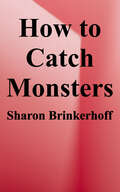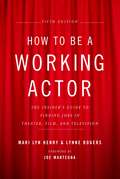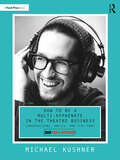- Table View
- List View
Huff & Stitch
by Cliff CardinalIn huff, brothers Wind, Huff, and Charles are trying to cope with their father’s abusive whims and their mother’s recent suicide. In a brutal reality of death and addiction, they huff gas and pull destructive pranks. Preyed upon by Trickster and his own fragile psyche, Wind looks for a way out, one that might lead him into his mother’s shadow. In Stitch, Kylie Grandview is a single mom struggling to make a living as a porn star while dreaming of being on the big screen. She’s painfully aware that she is among the many nameless faces on the Internet, the ones that blip across cyberspace, as her yeast infection, Itchia, reminds her at every turn. But when Kylie is offered the chance at a big break, a series of twisted events lead her down a destructive path, revealing a face no one will forget.
Huck & Holden
by Rajiv JosephFull Length, Comedy \ 3m, 2f \ Unit set \ Receiving rave reviews for both its New York and Los Angeles productions, Rajiv Joseph's Huck & Holden tells the story of Navin, an Indian college student who's fresh off the boat and trying to remain focused on his studies while the temptations of America and college life start beating down his door. When Navin falls for Michelle, a young African-American woman, he finds that his perceptions of the world begin to expand-- and crumble. Called "...a comingof-age story with comedy, pathos, and a distinct emotional core," by offoffline.com, Huck & Holden is a romantic comedy that wrestles with cultural stereotypes, racism, The Kama Sutra, The Catcher in the Rye, and how losing our innocence doesn't always make us wiser. \ "Joseph's writing has the smarts and sophistication to rip away stereotypes while revealing his characters' raw humanity. With simple storytelling, he deftly constructs Navin's coming-of-age story with comedy, pathos, and a distinct emotional core. This is theater at its finest, and theater that maters.... Everything in this highly polished production cries out for mention, but at the heart of it all is Joseph's taut, masterful script." --offoffonline.com
How You Get Famous: Ten Years of Drag Madness in Brooklyn
by Nicole PasulkaA madcap adventure through a tight-knit world of drag performers making art and mayhem in the greatest city on earth.Ten years ago, an aimless coat check girl better known today as Merrie Cherry sweet-talked her boss into giving her $100 to host a drag show at a Brooklyn dive bar. Soon, kids like Aja were kicking their way into the scene, sneaking into clubs, pocketing their tips to help mom pay the mortgage, and sharing the stage with electric performers like Thorgy Thor and Sasha Velour. Because suddenly, in the biggest, brightest city in America, drag was offering young, broke, creative queer people a chance at real money—and for thousands or even millions of people to learn their names. In How You Get Famous, journalist Nicole Pasulka joyfully documents the rebirth of the New York drag scene, following a group of iconoclastic performers with undeniable charisma, talent, and a hell of a lot to prove. The result is a sweeping portrait of the 21st-century search for celebrity and community, as well as a chronicle of all the struggles, fights, and disappointments along the way. A rollicking account of the quest to make a living through an art form on the cusp of becoming a cultural phenomenon, How You Get Famous offers an unmissable romp through the gritty and glamorous world of Brooklyn drag.
How to Write a Sentence: And How to Read One
by Stanley FishNew York Times Bestseller“Both deeper and more democratic than The Elements of Style” —Adam Haslett, Financial Times“A guided tour through some of the most beautiful, arresting sentences in the English language.” —SlateIn this entertaining and erudite gem, world-class professor and New York Times columnist Stanley Fish offers both sentence craft and sentence pleasure, skills invaluable to any writer (or reader). Like a seasoned sportscaster, Fish marvels at the adeptness of finely crafted sentences and breaks them down into digestible morsels, giving readers an instant play-by-play. Drawing on a wide range of great writers, from Philip Roth to Antonin Scalia to Jane Austen, How to Write a Sentence is much more than a writing manual—it is a spirited love letter to the written word, and a key to understanding how great writing works. It is a book that will stand the test of time.
How to Write a Pantomime (Secrets to Success)
by Lesley CookmanThere are thousands of pantomimes staged throughout the world every year, most of them in Britain. Most groups, whether they be amateur drama societies, schools, Women's Institutes or Village Hall committees are constantly on the lookout for something fresh and original. This is often a matter of economics, as professional pantomimes can be costly in terms of performing rights, let alone the cost of scripts. This book is aimed at those people who take part in this increasingly popular hobby, and at the writer who wishes to write a pantomime, either for a local group, or, indeed, for mass publication.
How to Think like Shakespeare: Lessons from a Renaissance Education (Skills For Scholars Ser.)
by Scott NewstokA lively and engaging guide to vital habits of mind that can help you think more deeply, write more effectively, and learn more joyfullyHow to Think like Shakespeare offers an enlightening and entertaining guide to the craft of thought—one that demonstrates what we've lost in education today, and how we might begin to recover it. In fourteen brief, lively chapters that draw from Shakespeare's world and works, and from other writers past and present, Scott Newstok distills vital habits of mind that can help you think more deeply, write more effectively, and learn more joyfully, in school or beyond.Challenging a host of today's questionable notions about education, Newstok shows how mental play emerges through work, creativity through imitation, autonomy through tradition, innovation through constraint, and freedom through discipline. It was these practices, and a conversation with the past—not a fruitless obsession with assessment—that nurtured a mind like Shakespeare's. And while few of us can hope to approach the genius of the Bard, we can all learn from the exercises that shaped him.Written in a friendly, conversational tone and brimming with insights, How to Think like Shakespeare enacts the thrill of thinking on every page, reviving timeless—and timely—ways to stretch your mind and hone your words.
How to Teach Your Children Shakespeare
by Ken LudwigA foolproof, enormously fun method of teaching your children the classic works of William Shakespeare, by a Tony Award–winning playwright—now featuring two new chapters &“You and your children will be transformed by the magic and mystery of Shakespeare and his stories in an instant.&”—Sir Derek Jacobi, CBE Winner of the Falstaff Award for Best Shakespeare BookTo know some Shakespeare provides a head start in life. His plays are among the great bedrocks of Western civilization and contain the finest writing of the past 450 years. Many of the best novels, plays, poems, and films in the English language produced since Shakespeare&’s death in 1616—from Pride and Prejudice to The Godfather—are heavily influenced by Shakespeare&’s stories, characters, language, and themes. In How to Teach Your Children Shakespeare, acclaimed playwright Ken Ludwig provides the tools you need to inspire an understanding, and a love, of Shakespeare&’s works in your children, and to have fun together along the way.Ken Ludwig devised his friendly, easy-to-master methods while teaching his own children. Beginning with memorizing short passages from the plays, his technique then instills children with cultural references they will utilize for years to come. Ludwig&’s approach includes understanding of the time period and implications of Shakespeare&’s diction as well as the invaluable lessons behind his words and stories. Colorfully incorporating the history of Shakespearean theater and society, How to Teach Your Children Shakespeare guides readers on an informed and adventurous journey through the world in which the Bard wrote.This book&’s simple process allows anyone to impart to children the wisdom of plays like A Midsummer Night&’s Dream, Twelfth Night, Macbeth, and Romeo and Juliet. And there&’s fun to be had throughout. Shakespeare novices and experts and readers of all ages will each find something delightfully irresistible in How to Teach Your Children Shakespeare.
How To Talk So People Will Listen: And Sound Confident (Even When You’re Not)
by Lizzie WaterworthFind your voice and own the room, even when your legs are shaking!Professional cartoon voice artist Lizzie Waterworth tells you all about her strategies for confident speaking, from breathing exercises to what to do with your hands, and how to conquer that pesky inner voice that whispers "what if...?".Packed with funny stories from Lizzie's world of cartoons, and top tips from a host of professional voice artists and public figures, such as Stephen Fry, David Menkin, and BBC presenter Ben Shires, this book is full of practical advice to help you find your voice!'We teach our children reading and writing but we forget listening and speaking, which are essential life skills. Lizzie brilliantly fills that gap for speaking in this fun, easy to read manual for children of all ages (and parents too!). Every child should have this!' - Julian Treasure, top-10 TED speaker and author of How To Be Heard'The book looks really brilliant - I will definitely be using it for homework sessions with my younger ones.' - Dr Natalie Cawley, counselling psychologist and psychotherapist'Lizzie has a terrific way of helping folks overcome natural fears about speaking in front of others, and this book very much captures her spirit and energy. In How to Talk so People Will Listen, she draws on her professional knowledge and experience to treat the topic seriously while also making it fun.' - James Tierney, Yale University English Language Programs'This book is perfect for helping young ones learn essential skills and grow self-confidence all whilst having fun reading!' - Claudia Dalley, Head of POP Channels'This book is great because it's instructional without being full of jargon...and it's funny too! Definitely one for children and adults even!' - Monique Berry, Headteacher'It&’s like a cartoon on the outside and inside the playfulness continues. I really think this book is an invaluable resource. Although this book is designed for young people, Lizzie&’s advice is applicable to people of any age.' - Ranny Levy, Founder and President, KIDS FIRST! / Coalition for Quality Children's Media
How to Swing in Musical Theatre: A Guide to Covering the Ensemble
by Jaye J. ElsterHow to Swing in Musical Theatre shines a light on the most universal techniques used by cast members who, in response to absence, can perform multiple roles across an ensemble. This entertaining guide can be used not only to build a step-by-step understanding of what swinging is and how it can be approached, but also as a constant point of reference throughout a career in musical theatre. Providing a suite of practical, technical advice on everything from quick and easy notation to compiling one’s own personal swing ‘bible’, everything that an aspiring or experienced musical theatre performer will need is clearly arranged and thoughtfully explained. This book also teaches the SAFE Strategy, which is recognised as the most functional swing method and introduces the SAFE Principles of Swinging: Safety, Awareness, Function and Evolution. The principles are an original construct, devised to ward off stress and invite positive experience through reasoned behaviours. Musical theatre performers at every level of the profession will find this an invaluable guide that elevates their craft no matter what their previous training, experience or success in the industry.
How to Stop Acting: A Renowned Acting Coach Shares His Revolutionary Approach to Landing Roles, Developing Them and Keeping Them Alive
by Harold Guskin Kevin KlineHarold Guskin is an "acting doctor" whose clients include Kevin Kline, Glenn Close, James Gandolfini, Bridget Fonda, and dozens more. In How to Stop Acting, Guskin reveals the insights and techniques that have worked wonders for beginners as well as stars. Instead of yet another "method," Guskin offers a strategy based on a radically simple and refreshing idea: that the actor's work is not to "create a character" but rather to be continually, personally responsive to the text, wherever his impulse takes him, from first read-through to final performance. <p><p> From this credo derives an entirely new perspective on auditioning and the challenge of developing a role and keeping it fresh, even over hundreds of performances. Drawing on examples from his clients' work and his own, Guskin presents acting as a constantly evolving exploration rather than as a progression toward a fixed goal. He also offers sound and original advice on adapting to the particular demands of television and film, playing difficult emotional scenes, tackling the Shakespearean and other great roles, and more. His book will find an eager and appreciative audience among novices and established actors alike.
How to Start Your Own Theater Company
by Reginald Nelson David SchwimmerWith hands-on advice and instruction from an experienced actor and theater director, this pragmatic, authoritative guide to starting a theater company imparts essential backstage know-how for would-be playhouse practitioners on everything from fundraising and finding a space to selecting plays and successfully navigating tricky legal issues. Chronicling three seasons at Chicago's award-winning Congo Square Theatre Company, this journey behind the curtain reveals the nitty-gritty details of practical issues that are often overlooked amidst the zeal of artistic pursuit, such as how to manage rent, parking, and safety issues; determine tax status and calculate budgets; and find flexible day jobs to help foster artists' creative passion. The guide also provides in-depth analysis of undertaking lofty projects--such as managing a coproduction with a large, established theater, as Congo Square did with Tony Award-winning Steppenwolf Theatre Company--and addresses potential drawbacks, such as handling common weaknesses of the "artistic temperament" that can often lead to a business venture's undoing. Inspired by Congo Square's own unique inception, the valuable how-to also speaks directly to the many underserved niche audiences who decide to create their own companies, including African American, Asian American, Latino, physically challenged, and GLBT communities. Concluding with lists of Equity offices, legal advisers, and important organizations for assistance, this complete resource is sure to help ambitious theater lovers establish and maintain their own successful companies.
How To Run A Theatre: A Witty, Practical And Fun Guide To Arts Management
by Jim VolzThe first edition of How to Run a Theatre sold out within months of initial publication and it took the cries of the field and pleadings of professors who use the book in their university classes to encourage me to search for a publisher for this second edition. <P><P>Fortunately, publisher Jenny Ridout with London's esteemed Methuen Drama/A & C Black Publishers Limited took time to review the book and take it to her Board. The results are before you - an updated edition with new sections, new contacts and new teaching tools.
How to Rehearse a Play: A Practical Guide for Directors
by Damon KielyBased on interviews with over forty award-winning artists, How to Rehearse a Play offers multiple solutions to the challenges that directors face from first rehearsal to opening night. The book provides a wealth of information on how to run a rehearsal room, suggesting different paths and encouraging directors to shape their own process. It is divided into four sections: lessons from the past: a brief survey of influential directors, including Stanislavski’s acting methods and Anne Bogart’s theories on movement; a survey of current practices: practical advice on launching a process, analyzing scripts, crafting staging, detailing scene work, collaborating in technical rehearsals and previews, and opening the play to the public; rehearsing without a script: suggestions, advice, and exercises for devising plays through collaborative company creation; rehearsal workbook: prompts and exercises to help directors discover their own process. How to Rehearse a Play is the perfect guide for any artist leading their first rehearsal, heading to graduate school for intense study, or just looking for ways to refresh and reinvigorate their artistry.
How to Read a Play: Script Analysis for Directors
by Damon KielyThe work done on a play before the first rehearsal, the first group reading or even the before the cast have met, can be crucial to the success of a production. Directors and dramaturgs must know how to analyze, understand and interpret a play or performance text if they hope to bring it to life on the stage. This book provides a broad range of tools and methods that can be used when reading a text, including: Lessons from the past. What can we learn from Aristotle, Stanislavsky, Meyerhold, Vakhtangov, Brecht and Harold Clurman? This section establishes the models and methods that underpin much of a director’s work today. A survey of current practices in Western theatre. A combination of research, interviews and observation of practical work addresses the main stages in understanding a play, such as getting to know characters, sharing ideas, mapping the action and grappling with language. A workbook, setting out twenty one ways of breaking down a play, from the general to the particular. Contributions, reflections and interjections from a host of successful directors make this the ideal starting point for anyone who wants to direct a play, or even devise one of their own. This wide range of different approaches, options and techniques allows each reader to create their own brand of play analysis.
How To Make Friends and Then Kill Them: A Play
by Halley FeifferThe uproarious and borderline repulsive play about two neglected sisters and their oddball friend by the author of I’m Gonna Pray For You So Hard. Left to their own devices by their alcoholic mother, Ada and Sam cultivate an insular world into which they soon draw a third wheel – a pockmarked, limping wallflower named Dorrie. In the years spanning childhood to young adulthood, these three troubled girls learn to lean on each other completely, finding ways to fill each other up and to tear each other down. But when a horrible accident turns their reality upside down, they find they must decide whether they will continue to foster their familiar, codependent cycle, or whether they will break free, with or without each other’s aid.
How to Improvise a Full-Length Play: The Art of Spontaneous Theater
by Kenn AdamsForget the script and get on the stage! In How to Improvise a Full-Length Play, actors, playwrights, directors, theater-group leaders, and teachers will find everything they need to know to create comedy, tragedy, melodrama, and farce, with no scripts, no scenarios, and no preconceived characters. Author Kenn Adams presents a step-by-step method for long-form improvisation, covering plot structure, storytelling, character development, symbolism, and advanced scene work. Games and exercises throughout the book help actors and directors focus on and succeed with cause-and-effect storytelling, raising the dramatic stakes, creating dramatic conflict, building the dramatic arc, defining characters, creating environments, establishing relationships, and more. How to Improvise a Full-Length Play is the essential tool for anyone who wants to create exceptional theater.
How to Host a Viking Funeral: The Case for Burning Your Regrets, Chasing Your Crazy Ideas, and Becoming the Person You're Meant to Be
by Kyle ScheeleAn inspiring speaker and artist asked 20,000 people around the world to share the regrets they wanted him to burn in a mock Viking ship. This is the story of what he learned about letting go of the pain of the past and embracing the future with hope.Turning 30, artist and speaker Kyle Scheele wanted to do something unusual to mark this milestone. Instead of a birthday bash, he decided to hold a funeral to memorialize the decade of his life that was ending. Building a 16-foot Viking ship out of cardboard, he invited friends to help him set it on fire—a symbolic farewell to his 20s and all the grief, regret, and mistakes that accompanied those years. When video of his Viking funeral went viral, it encouraged many others to let go of past hurts as well. Moved by the response he received, Kyle planned a second funeral (this time with a 30-foot cardboard Viking ship) and asked people to share the things they carried—the bad choices, disappointments, heartaches, and negative thinking that they wanted to lay to rest. He received more than 20,000 responses from around the world—stories both heartbreaking and hilarious, painful and inspiring. In this entertaining and wise book, Kyle reflects on what he discovered about freeing ourselves from the pain of the past, interweaving anecdotes from those who participated with the story of his own journey of renewal. “This story involves multiple Viking funerals, thousands of square feet of cardboard, and enough hot glue to supply your mother-in-law's craft night for the rest of time,” he writes. “But it also involves regret, self-doubt, insecurity, and ultimately, redemption. So buckle up. It's about to get bumpy.”How to Host a Viking Funeral is the story of letting go of the people we used to be, but no longer want to be. It’s about renewal; where there was once regret there is now blank space—an opportunity for a fresh start.
How to Enjoy Shakespeare
by Robert Thomas FallonIn How to Enjoy Shakespeare, the author explores Shakespeare's familiarity in five sections dealing with language, theme, staging, character, and plot, each abundantly illustrated with episodes and quotations from the plays.
How to Do Things with Dead People: History, Technology, and Temporality from Shakespeare to Warhol
by Alice DaileyHow to Do Things with Dead People studies human contrivances for representing and relating to the dead. Alice Dailey takes as her principal objects of inquiry Shakespeare's English history plays, describing them as reproductive mechanisms by which living replicas of dead historical figures are regenerated in the present and re-killed. Considering the plays in these terms exposes their affinity with a transhistorical array of technologies for producing, reproducing, and interacting with dead things—technologies such as literary doppelgängers, photography, ventriloquist puppetry, X-ray imaging, glitch art, capital punishment machines, and cloning. By situating Shakespeare's historical drama in this intermedial conversation, Dailey challenges conventional assumptions about what constitutes the context of a work of art and contests foundational models of linear temporality that inform long-standing conceptions of historical periodization and teleological order. Working from an eclectic body of theories, pictures, and machines that transcend time and media, Dailey composes a searching exploration of how the living use the dead to think back and look forward, to rule, to love, to wish and create.
How to do Shakespeare
by Adrian NobleThe author has worked on Shakespeare with everyone from Oscar-nominated actors to groups of schoolchildren. Here he draws on several decades of top-level directing experience to shed new light on how to bring some of theatre’s seminal texts to life. <p><p> He shows you how to approach the perennial issues of performing Shakespeare, including: wordplay – using colour and playing plain, wit and comedy, making language muscular; building a character – different strategies, using the text, Stanislavski and Shakespeare; shape and structure – headlining a speech, playing soliloquys, determining a speech’s purpose and letting the verse empower you; dialogue – building tension, sharing responsibility and ’passing the ball’. <p><p> This guided tour of Shakespeare’s complex but unfailingly rewarding work stunningly combines instruction and inspiration.
How to Direct a Musical
by David YoungHow to Direct a Musical is a lively and practical guide to the seemingly overwhelming task of directing a musical. David Young brings to this handbook his extensive experience as a director of over 100 productions and more than 250 workshops in the US, China, Senegal and Brazil. Young takes a pragmatic, do-it-yourself approach, guiding the reader from planning to casting, rehearsal to opening night. Topics covered include script analysis, collaboration with designers, musical directors, choreographers and crew, eliminating lengthy pauses between scenes, dress rehearsals and curtain calls.
How to Defend Yourself (Yale Drama Series)
by Liliana PadillaA Yale Drama Series-winning play about self-defense, desire, and healing in the aftermath of a college rape Seven college students gather for a DIY self-defense workshop after a sorority sister is raped. They practice using their bodies as weapons. They wrestle with their desires. They learn the limits of self-defense. This new play by writer, director, actor, and community builder Liliana Padilla explores the intersection of sex, community, and what it means to heal in a violent world. Padilla shows how learning self-defense becomes a channel for these college students&’ rage, anxiety, confusion, trauma, and desire. The play examines what one wants, how to ask for it, and the ways rape culture threatens one&’s body and sense of belonging. It is the thirteenth winner of the Yale Drama Series prize and the second one chosen by Pulitzer Prize–winning playwright Ayad Akhtar.
How to Catch Monsters
by Sharon BrinkerhoffThis book is a wonderful role-play reading adventure! Playbook stories are presented in a unique and colorful format and are read out loud by several readers like a play, without memorization, props, or a stage. <p><p>When you read the book, you and other readers bring the story to life and become the characters. As you read your part out loud, you will have fun expressing and acting like your character. You and the other readers will explore the story plot together and learn what will happen next. It's an exciting journey of discovery that pulls you into the story, and you'll want to read it out loud again and again! <p><p>Begin your reading adventure with the Character Summary at the beginning of the book. You'll notice right away that the words and sentences for each character appear in a different color here and throughout the book. This will make it easy to follow along and read your part with confidence and enthusiasm.
How to Be a Working Actor: The Insider's Guide to Finding Jobs in Theater, Film, and Television
by Mari Lyn Henry Lynne RogersThis comprehensive guide has been revised and expanded to include new information on enhancing your image; finding jobs in emerging markets; updated union rules and payscales; current living expenses; and an entirely new chapter on “Cyberbiz,” exploring the ways that the Internet has opened new doors for actors and enabled entirely new approaches to promotion. Establishing your acting career entails developing all aspects of your performing skills, but more than that, it means learning how to manage your career as an ongoing business. Plenty of schools and books teach you how to hone specific areas of your talent, but onlyHow to Be a Working Actorshows you the whole picture, from improving your image and your audition abilities to finding an agent and landing the roles; from surviving a screen test to making it through your first day on the set; from making your way around the big city to finding regional work. Cowritten by a leading casting director/agent and a seasoned actress/author,How to Be a Working Actoris still the bible of The Biz, with an insider’s viewpoint on all the essentials: assembling a dynamic resume, taking the perfect headshot, understanding the unions, finding a “day job” to supplement your income, learning how to live on a budget in New York or Los Angeles, networking, and much more. Countless tips on wardrobe, makeup, interview skills, and character analysis demonstrate how you can look and act your best for any audition or acting situation. Dozens of industry professionals offer authoritative advice gleaned from decades of experience. Anyone seeking to become—or remain—a working actor needs a copy of this indispensable book.
How to Be a Multi-Hyphenate in the Theatre Business: Conversations, Advice, and Tips from “Dear Multi-Hyphenate”
by Michael KushnerHow to Be a Multi-Hyphenate in the Theatre Business empowers theatre professionals to take hold of their own career and become successful ‘multi-hyphenates’– artists with multiple proficiencies, often cross-pollinating each other to help flourish professional capabilities. Discussing self-identity, networking, workflow, failure, passion, purpose, socially responsible artistry, social media, and the effects of COVID-19, Michael Kushner, award-winning theatre multi-hyphenate artist, sets the stage for artists of all disciplines and backgrounds to find personalized success in the theatre industry. Complete with informative and lively exercises and excerpts from Kushner’s popular podcast and workshop, Dear Multi-Hyphenate, this book addresses questions such as: How do we recover from a pandemic? How do we give more access to marginalized theatre creators? and What goes into producing our own projects? Featuring exclusive information from a myriad of theatre makers such as agents, managers, designers, actors, press representatives, producers, comedians, social media stars, writers, executive directors, CEOs, and lawyers, this book promotes the dismantling of gatekeeping and provides a specialized, hands-on experience to an innovative and lucrative approach to theatre making. How to Be a Multi-Hyphenate in the Theatre Business is an invaluable resource for theatre artists at any level in their careers, whether they are undergraduates, graduate students, professors, award-winning members of the theatre and film community, working professionals, high school students, or entrepreneurs.
